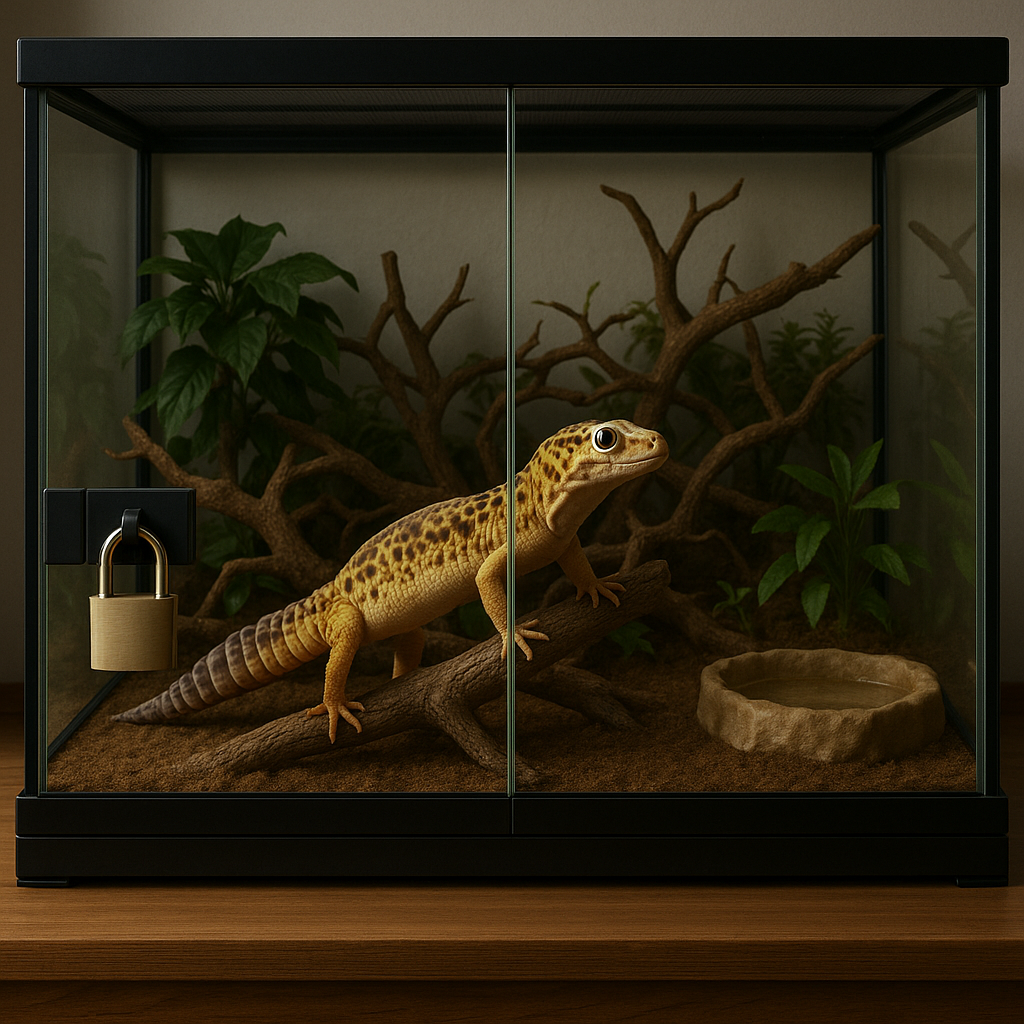How to Prevent Losing Your Reptile: Tips for Terrarium and Outdoor Safety
By Lost'Him Team • February 22, 2025

Reptiles—whether snakes, lizards, geckos, chameleons, or tortoises—are expert escape artists. A poorly secured enclosure, a brief moment of negligence, or an unsuitable environment can encourage them to flee. Additionally, certain species, like tortoises, can dig, climb, or move surprisingly fast when given the opportunity.
Losing a reptile is particularly concerning, as they are vulnerable in the wild due to unsuitable temperatures, predators, traffic, and human hazards. Preventing escapes is essential. Here’s a complete guide to avoiding the loss of your reptile, whether they live in an indoor terrarium or an outdoor enclosure.
1. Secure the Indoor Terrarium
Reptiles in terrariums may seem \"safely enclosed,\" but a single weak point can allow an escape.
👉 Check and reinforce weak spots in the terrarium
- Reliable locking system: Use secure locks and avoid simple sliding doors without a locking mechanism.
- Check vents and openings: Install sturdy metal mesh with holes smaller than 5 mm.
- Monitor cables and electrical devices: Reptiles can push or chew on cables, creating weaknesses in the structure.
💡 A high-quality, well-locked, and well-maintained terrarium significantly reduces escape risks.
2. Prevent Escapes During Handling
Reptiles are often handled for feeding, cleaning, or interaction. This is a critical moment when escapes are most likely.
👉 Best practices for safe handling:
- Always handle in a closed room: Shut doors and windows before picking up the reptile.
- Use gloves if necessary: Some reptiles (chameleons, iguanas) may bite when stressed, causing them to flee.
💡 Be especially cautious with young or nervous reptiles, as they are often more agile and unpredictable.
3. Secure Outdoor Enclosures (Tortoises, Iguanas, Lizards)
Outdoor enclosures provide a stimulating environment, but they also increase the risk of escape.
👉 Build a safe and well-adapted outdoor enclosure:
- Bury fencing underground: For terrestrial tortoises, fences should be buried at least 30–50 cm deep, as they are excellent diggers.
- Use anti-climb barriers: Some reptiles, like geckos and iguanas, are skilled climbers. Install inward-curved edges to prevent climbing.
- Increase supervision: Never leave a reptile unattended for long periods, especially in open terrain.
- Protect against predators: Cover part of the enclosure with strong mesh to prevent attacks from birds of prey, dogs, or cats.
💡 A well-secured and regularly inspected enclosure prevents most outdoor escapes.
4. Regularly Inspect the Habitat and Environment
Reptiles are persistent and regularly test the weak points of their enclosure.
👉 Establish a routine inspection plan:
- Weekly terrarium checks: Inspect seals, doors, vents, locks, and accessories.
- Monitor outdoor enclosures: After storms, frost, or extreme heat, check fences and the ground for escape routes.
- Ensure electrical devices are secure: Reptiles may pull on cables and displace temperature sensors.
💡 Regular inspections prevent weaknesses that could lead to escapes.
5. Educate and Inform Your Household
👉 Everyone should adopt good practices to prevent escapes
- Explain the rules to children and visitors:
- Never open the terrarium without permission.
- Never handle a reptile alone.
- Train the family in safe handling: Teach proper techniques for holding a reptile and recognizing signs of stress.
- Establish clear rules for outings: Always handle the animal in a closed, secure space.
💡 A reptile can escape in seconds if safety guidelines aren’t followed.
6. Anticipate Escape Behavior
Reptiles may attempt to escape due to instinct, particularly when they:
- Seek a mate (during breeding season).
- Experience stress (noise, excessive handling).
- Try to escape unsuitable conditions (temperature, humidity issues).
👉 Adapt the environment to reduce these behaviors:
- Maintain optimal conditions: Temperature, humidity, day/night cycle.
- Minimize handling during shedding periods.
- Provide hiding spots and retreat areas: To reduce escape attempts triggered by stress.
💡 A well-adjusted reptile is less likely to seek an exit.
Conclusion: Vigilance and Prevention to Prevent Losing Your Reptile
- ✅ Secure the terrarium with strong locks and reinforced grilles.
- ✅ Supervise handling and always close doors and windows.
- ✅ Build a secure outdoor enclosure with buried fencing and anti-climb barriers.
- ✅ Regularly inspect installations and fix any weaknesses.
- ✅ Educate family members and visitors.
- ✅ Anticipate escape behaviors by maintaining optimal conditions.
💡 A safe reptile is a happy reptile. Preventing escapes ensures their well-being and your peace of mind. 🦎💚
 EN
EN  FR
FR